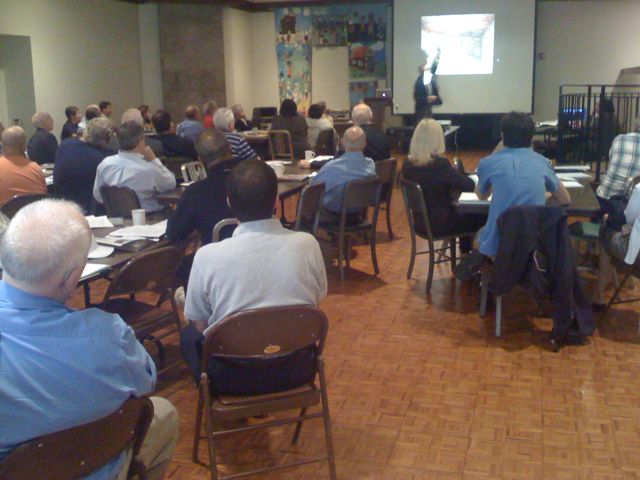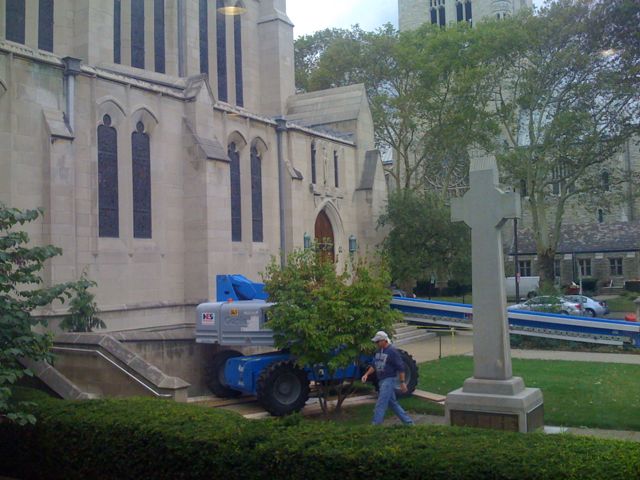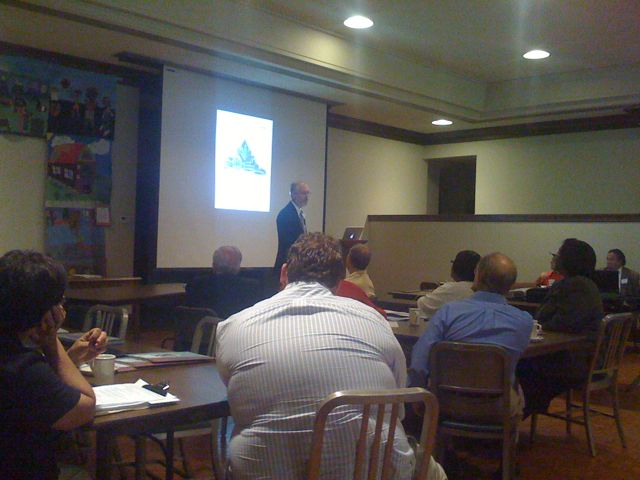
Category Archive: Education
-
Landmarks Community Capital Corporation & Carnegie Mellon University’s Heinz College Hold Landmarks Economic Development Case Challenge
PHLF News
November 14, 2008
by Michael SriprasertIn light of the recent efforts to bring a grocery store to the Hill District, Landmarks Community Capital Corporation, in partnership with the Heinz College, engaged 25 students in the Heinz Colleges’ first ever non-profit case challenge. Titled the “Landmarks Economic Development Case Challenge”, students were introduced to the issue that is gaining more attention both locally and nationally: The dearth of quality grocery stores locating in urban markets.
LCCC presented the topic to students and took them on a site visit to the Hill District to speak with local leadership engaged in the grocery store development. LCCC then took the students to Wilkinsburg to meet with the Mayor and the owner of the Save-A-Lot that just opened two years ago to give students a better understanding of the impact grocery stores can have in urban markets and to give them more insight into the business of operating a grocery store in these types of areas.
After a week of conducting their own due diligence, the students presented on which development they thought would have the greatest likelihood to succeed and would drive positive change for the Hill District and for its residents The panel of judges was made up of professors, economic development professionals, City of Pittsburgh leaders, business professionals from the Hill District and Wilkinsburg, and LCCC staff. The judges all agreed that the presentations were excellent, and making a decision about the top three was very difficult. After over an hour of deliberation, the winning teams were decided upon:
1st Place Winners – Save-A-Lot
Chapel Dcunha, Jebran Syed, Shruti Mohandas, Emily Burnett, Ling Zhai2nd Place Winners – Kuhns
Russell Pustejovsky, Matt Solomon, Jarrod West, Eddie Wilson3rd Place Winners – Save-A-Lot
Conrhonda Baker, Tramaine Brathwaite, Jennifer Clarke, Hanna SmithLCCC & PHLF would like to congratulate all those who participated in the Landmarks Economic Development Case Challenge, and would especially like to thank the Heinz College for engaging LCCC in this great event.
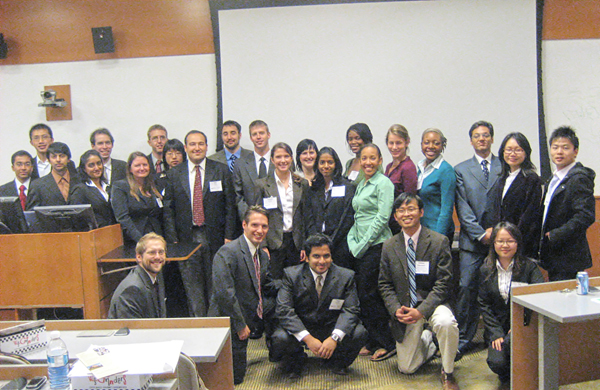
Participants were:
- Conrhonda Baker
- Tramaine Brathwaite
- Emily Burnett
- Jennifer Clarke
- John Cowen
- Chapel Dcunha
- Leigh Halverson
- Kristin Kennedy
- Ashish Mehra
- Sruti Mohandas
- Eric Morris
- Russell Pustejovsky
- Rhajiv Ratnatunga
- Lavanya Shaji
- Hanna Smith
- Matt Solomon
- Michael Spotts
- Jebran Syed
- Huimin Tan
- Zhenyue Wang
- Lu Wang
- Jarrod West
- Eddie Willson
- Jingyi Xu
- Ling Zhai
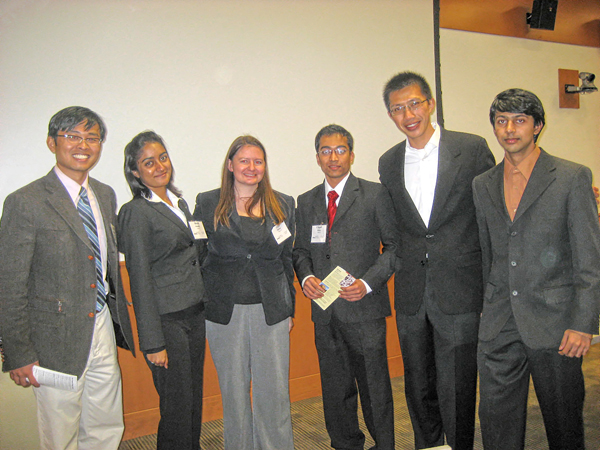
To find out more information about this case challenge, please contact Michael Sriprasert at (412) 471-5808
-
Technical Assistance Workshop for Guardians of Historic Religious Properties
PHLF News
September 5, 2008On Monday, September 15, the Historic Religious Properties Committee of Pittsburgh History & Landmarks Foundation (PHLF) will host a technical assistance workshop at Calvary Episcopal Church, 315 Shady Avenue, from 9:30 a.m. to 3:00 p.m. Congregation leaders, representatives, and guardians of historic religious properties in Allegheny County are invited to attend. The workshop fee of $25 includes box lunches for up to three people.
“Historic religious properties play a significant role in the spiritual, social, cultural and educational life of this region,” says George C. Dorman, Chair of PHLF’s Historic Religious Properties Committee, “and we know how difficult it is for congregations with limited budgets to preserve and maintain their architecturally-significant historic structures. Therefore, it is our goal to help these congregations by offering this workshop that will answer questions they may have and help them care for their buildings.”
This workshop will give congregation leaders an opportunity to speak with professionals in the field of building construction and maintenance.
Experts will speak on:
• Prioritizing building projects;
• Planning and organizing building projects;
• Financing a project: raising funds, seeking grants and loans;
• Working with contractors, getting bids and estimates, contracting the work;
• Stained glass window restoration, masonry work, roof and gutter replacement and repair;
• Energy conservation in large structures.Historic Religious Properties Technical Assistance Workshop
The workshop will feature assistance in prioritizing, planning, and organizing building projects; financing a project; working with contractors; specific building maintenance issues; and energy conservation in large structures. You will have the opportunity to ask questions of the presenters and network with other church leaders.
When you come, please bring a list of questions and photos of your structures demonstrating areas where maintenance is needed and where you have successfully done work.
Plenty of off-street parking is available in Calvary Episcopal Church’s parking lot.
- Time: 10:00 a.m.
to 3:00 p.m. - Meeting Location: Calvary Episcopal Church, 315 Shady Avenue. (Google Street View Map)
- Fee : $25, includes up to 3 people from your church or synagogue and box lunches.
- RSVP one day before this event. Contact Carole Malakoff, Historic Religious Properties Coordinator at hrp@phlf.org.
Program Agenda:
- 9:30: Coffee and Registration
- 10:00: Welcome
- Mark Bibro, Chairman, PHLF Board of Trustees
- George C. Dorman, Chairman, PHLF Historic Religious Properties Committee
- Arthur Ziegler, President, PHLF
- Tom Keffer, Property & Construction Manager, PHLF
- 10:30: Jack Scalo and Jacqui McMenamin, Burns and Scalo Roofing (dealing with roof problems)
- 11:00: John Kelly, Kelly Art Glass (preservation and maintenance of stained glass windows)
- 11:30: David Hounshell, member, First Methodist Church of Pittsburgh and professor, CMU Departments of History and Social & Decision Sciences (planning and organizing a church building project)
- 12:00: Sister Florence Lynch, CEO, Angels in Overalls; Jack Miller, PHLF (organizing a project and the role of volunteers)
- 12:30: Lunch
- 1:15: Greg Smith, Keystone Waterproofing; Aaron Wolk, Cathedral Stone Products (brick and masonry preservation)
- 1:45: Greg Wozniak––G. A. Wozniak & Assos., Energy Management & Consulting
(conserving energy in historic religious structures)
- 2:15: Susan Brandt, PHLF Trustee (searching for grants and loans: approaching funding sources)
Some photos of the workshop in progress.
- Time: 10:00 a.m.
-
Cost of new Mt. Lebanon high school: $132 million
By Tim Puko
TRIBUNE-REVIEW
Wednesday, July 23, 2008It would cost the Mt. Lebanon School District close to $132 million in construction costs alone to build a high school, project architects said Tuesday night.A new building is one of four options the district can consider for the high school, the architects told about 300 residents who attended a special meeting to hear the possibilities.The district needs at least $79.8 million to pay the cost of renovations to the building, including a new roof, asbestos abatement and facilities improvements, said Kerry Leonard of the OWP/P design firm in Chicago.
The architects spent most of their time talking about the midpriced option, an estimated $118.7 million combination of renovation and new construction.
That option and the new high school option are anchored around a glass-enclosed, multifloor commons area, which could include an open library and other social and collaborative workspaces.A fourth option would include improvements to educational space on the high school’s 80-year-old campus off Route 19.The main building of the high school along Cochran Road is to be preserved in all the project options, something community residents demanded, architects said.
The project was an issue in last year’s school board elections, where rumors about the cost were used against incumbent candidates.
Yesterday was the first time the expected cost of the options was made public.
“The modifications to this building will be expensive and difficult to afford,” board member Elaine L. Cappucci acknowledged. “But what we cannot afford is to do nothing.”
Architects and district officials talked about the plans for more than 90 minutes in the high school auditorium.
“What I’m seeing here is something that’s completely modern and something that’s completely new, but doesn’t pay attention to the design aesthetics of the (older) community it’s in,” said resident and parent Jim Martin. “I’m worried it’s going to stick out like a sore thumb.”
District officials have tried to brace the community for the project’s impact. They have had regular updates from the architects at board meetings, created a blog dedicated to the project on the district’s Web site and frequently promoted yesterday’s meeting.
More than half of the district’s utilities costs stem from the high school, and there are limitations for one building on the campus because of asbestos, Cappucci said.
The district needs to decrease capacity to match decreasing enrollment, she said.
The renovation and new building options would make the high school about 20 percent smaller than the current school.
Enrollment last year was 1,912; new construction and major renovations are targeting an 1,800-student capacity.
Architects and district officials want classroom clusters and space for collaborative educational programs to be a centerpiece of the redesign, a common goal in contemporary school building projects.
Funding for the project will have to be made through bonds, Superintendent John R. Allison said.
District officials plan to choose their design by mid-September.
Tim Puko can be reached at tpuko@tribweb.com or 412-320-7991.
-
Cathedral of Learning trumpets education
By Bill Zlatos
TRIBUNE-REVIEW
Sunday, June 29, 2008The Cathedral of Learning was constructed of Indiana limestone and built with the pennies, nickel and dimes of area schoolchildren.John G. Bowman, then chancellor of the University of Pittsburgh, came up with the idea for a tower in 1921.
“He wanted a tall building because his intention was the children of working men and women of Pittsburgh would see the tower and be inspired to get an education,” said Albert Tannler, historical collections director at the Pittsburgh History & Landmarks Foundation.

But there was the issue of money. The cost of the building was estimated at $10 million to $15 million, a hefty sum in those days.
In 1925, Marcus Aaron, chairman of the city’s board of education, summoned the district’s teachers to start a “Buy a Brick” campaign. The teachers told students to give 10 cents to Pitt and tell the university how they earned it. The children would get a certificate indicating they owned a piece of the building.As a result, 97,000 certificates were issued.Parents also gave. In 1926, Bowman went to a meeting of steelworkers and their families in Carnegie to promote his tower.
“A woman stood up with a baby in her arms and said, ‘We got no money, but we’ll go without meat for a week and give you that money.’ Then a man stood up and said, ‘I’ll wear this suit another year and give you the money,’ ” said Maxine Bruhns, director of Pitt’s Nationality Rooms and Intercultural Exchange Programs, who is working on a DVD, “The Story Behind the Construction of the Cathedral of Learning.”
The cathedral is home to 27 Nationality Rooms, which showcase the culture of the ethnic groups that built Pittsburgh.
The steel skeleton of the building was erected in 1929. After the stock market crashed, the 52-story design was shortened to 40. Still, it was the tallest academic building in the world when it was finished in 1937. It remains the biggest in the United States.
“It was a triumph,” Bruhns said, “symbolizing that those parallel lines going skyward never meet and education never ends.”
Bill Zlatos can be reached at bzlatos@tribweb.com or 412-320-7828.
-
$80 million Schenley tab challenged
By Christian Morrow
June 27, 2008
The New Pittsburgh Courier -
School board votes to close Schenley building
Thursday, June 26, 2008 -
Children’s Museum still looking to grow
Thursday, June 26, 2008At 25, the Children’s Museum of Pittsburgh has grown into a mature nonprofit and community leader — although it’s still all about kids.
Originally called the Pittsburgh Children’s Museum, it was on the leading edge of a wave of children’s museums that began opening around the country in the ’80s.
The idea for a children’s museum here dates back to 1972, when a group of community leaders established The Pittsburgh Children’s Museum Project — a mobile traveling museum that started at the Three Rivers Arts Festival.
The physical space opened its doors in the basement of the historic North Side post office building in Allegheny Center in June 1983. The Junior League of Pittsburgh got the project off the ground. Two years later, it expanded to the rest of the building, quadrupling its space and housing an exhibit of puppets from the collection of puppeteer Margo Lovelace.
The ’90s brought other key developments. The Pittsburgh History & Landmarks Foundation deeded the post office building to the museum. The museum launched several educational outreach programs and hosted its first traveling exhibit — “Kidsbridge.” In 1995, another traveling exhibit built around the works of “Sesame Street” creator Jim Henson set attendance records at the museum. In ’98, the museum created a major traveling exhibit of its own: “Mister Rogers’ Neighborhood — A Hands-On Exhibit.” There were two traveling versions of the Rogers exhibit. One is now part of the museum’s permanent collection; the other was donated to the New Orleans Children’s Museum in 2007.
The 21st century also has been a period of ambitious growth. In 2004, the museum expanded again into the former Buhl Planetarium building next door. The museum exceeded its goal in the $28 million capital campaign that funded the expansion, but there were challenges and hurdles, recalls then-board president Anne Lewis, who led the expansion effort and who is now board member emeritus.
“The long-term vision was always to create a community for kids,” Lewis says. “That meant the entire area needed to be brought back with economic development. We knew we had to become the leader and the catalyst for change.”
“The expansion allowed us to do things we’ve always dreamed of doing,” says Children’s Museum executive director Jane Werner.
Increased exhibition space and parking space have raised attendance: This year, the museum set a new attendance record, with a projected 228,000 admissions for the current fiscal year, which ends June 30.
“People are looking at the Children’s Museum as a new model of how to do children’s museums,” Werner says. “It’s been really fun to push those boundaries and try different things. We’ve enjoyed working with artists and taking chances.”
The museum places high priority on designing and building its own exhibits. “In the ’80s, people started to drift away from that and go with outside consultants,” Werner says. “We decided that we really wanted to stay in-house and make sure that our exhibits worked. We’ve gone back to that, and I think people are seeing the value in it.”
Looking ahead to the future, the museum and its neighboring institutions are poised for new growth. The Children’s Museum is in the middle of a $22 million capital campaign to raise the funds to create a green park space in the plaza area in front of the museum, extending the kid- and family-friendly environment outdoors and creating an example of how urban spaces can be green by using bioswales — landscaping elements that use plants to remove pollutants from runoff.
The Children’s Museum is also spearheading the Charm Bracelet Project, an effort to link North Side cultural organizations and create a unified cultural district in that neighborhood.
Lewis is enthusiastic about the museum’s future plans. “You want to bring that experience outside, so that synergy between inside and what’s outside becomes welcoming for kids.”
Adrian McCoy can be reached at amccoy@post-gazette.com or 412-263-1865.First published on June 26, 2008 at 12:00 am -
Region’s renaissance shines through as another span is lit
By F.A. Krift
TRIBUNE-REVIEW
Friday, June 13, 2008For Mark Bibro, the Hot Metal Bridge is more than a way to get to opposite shores of the Monongahela River.The Pittsburgh History & Landmarks Foundation chairman says it’s a symbol of Pittsburgh’s industrial past, and a connection point for the city’s future in research jobs and riverfront redevelopment. Illuminating the bridge Thursday night was another sign of the changes Pittsburgh continues to make as it reinvents itself.
“Suddenly, we’ve created high-tech jobs that will be here forever across the bridge,” Bibro said as he pointed to the Monongahela River’s north side. “On this side, it’s the place to go in Pittsburgh.”
Gov. Ed Rendell told electricians to “light up the bridge” by its South Side exit, and red, yellow and orange lights turned on, completing a $150,000 Pittsburgh History & Landmarks Foundation decorative lighting project on the century-old bridge.
Cities are built on feeling as much as substantive measures like improved schools and balanced budgets, Rendell said. Illuminating bridges like the Hot Metal Bridge shows how Pittsburgh continues to renew itself, he said.Anthony Owens, 42, of Overbrook stopped his bike ride to watch the ceremony. After years away from his hometown, he returned to Pittsburgh in 2004 and couldn’t believe how the South Side’s shore had changed from steel mills into a retail spot. Lighting the bridge was a validation of the transformation, he said.“It’s amazing,” Owens said. “I’m a fan of what’s happened here.”
The colors on the bridge are supposed to represent the liquefied metal that once traveled on the Hot Metal Bridge. Ladle cars took the molten metal from Jones & Laughlin Steel Corp. blast furnaces on the Monongahela’s north shore to south side open hearth furnaces. Now, people on foot, on bicycles and in cars travel to the SouthSide Works living, dining and entertainment center.
“Today, ideas are transported across this bridge via young people on bikes,” said Christine Fulton, vice president of external relations for Soffer Organization.
The Hot Metal Bridge connects SouthSide Works at South 29th Street to Oakland’s Second Avenue and spans 321 feet and 4 inches from bank to bank. It crosses the Monongahela 3.1 miles upstream from Point State Park’s fountain.
Using the bridge makes good use of an artifact from Pittsburgh’s smoky steel-based past, History & Landmarks Foundation President Arthur Ziegler said, while the city progresses toward pushing service industry growth and riverfront redevelopment.
The incandescent tubular lighting trims the entryways of the vehicle bridge, which was originally the railway bridge. The adjacent bridge actually was the crossing used to carry molten metal between facilities, but the twin spans now are commonly referred as the Hot Metal Bridge.
The bridge opened two lanes to vehicles in 2000. In 2007, the downstream bridge was opened for pedestrian and bicycle traffic.
The Pittsburgh History & Landmarks Foundation previously lit the Smithfield Street Bridge and the Roberto Clemente Bridge decoratively.
“We want to light all the bridges here,” Ziegler said. “We’re the ‘City of Bridges.’ This is a good one to do because we were trying to enliven the entrance from Second Avenue into the South Side.”
Pittsburgh has 446 bridges, more than any other city in the world. Thirty span a river.
A $125,000 grant from the state Department of Community and Economic Development at Rendell’s request primarily funded the Hot Metal Bridge project. Additional funding came from the Soffer Organization, the International Brotherhood of Electrical Workers, Wellington Power Corp. and the History & Landmarks Foundation
F.A. Krift can be reached at bkrift@tribweb.com or 412-380-5644.


